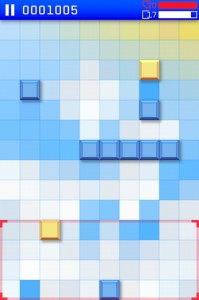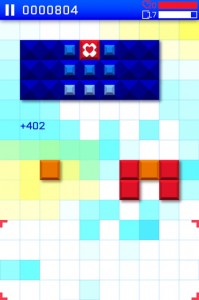 If Tetris went out, got trashed, hooked up with an old-school shooter like Space Invaders and then spit out a video game love child, the offspring would resemble MecaPix [$.99 / Lite]. It’s a slick combination of two genres that seem like they’d mix no better than oil and water, but what Robotalism managed to make is a fun, sharp pairing that strokes the shooter and the puzzle itch with the same scratcher. I just wish it wasn’t tuned for us non-mutant folks.
If Tetris went out, got trashed, hooked up with an old-school shooter like Space Invaders and then spit out a video game love child, the offspring would resemble MecaPix [$.99 / Lite]. It’s a slick combination of two genres that seem like they’d mix no better than oil and water, but what Robotalism managed to make is a fun, sharp pairing that strokes the shooter and the puzzle itch with the same scratcher. I just wish it wasn’t tuned for us non-mutant folks.
Think of MecaPix as Tetris with guns, but also in reverse. In Tetris, the object of the game is to stack together a continually descending assortment of blocks in order to create a line. In MecaPix, the object is to create and shoot your own blocks upwards towards falling blocks. When a successful collision is happens, the falling blocks disappear into the ether. If you miss a block or eighteen, these rogues blocks steal a pip from your overall health bar.
 The bottom area of the screen is where all the magic happens — the block creation, the firing, and at the very bottom, the pain you could potentially suffer from letting a block through your defenses. Because this area is relatively small, block anticipation is a key strategic element, as well as a good amount of precision.
The bottom area of the screen is where all the magic happens — the block creation, the firing, and at the very bottom, the pain you could potentially suffer from letting a block through your defenses. Because this area is relatively small, block anticipation is a key strategic element, as well as a good amount of precision.
Conservation has its place, too. You can’t fire willy-nilly because there’s a bar for that as well, which recharges slowly as you play.
After a few levels, you get a real sense of the push and pull and the amount of design resources that went into the enemy blocks. These aren’t your run-of-the-mill descending puzzle squares, but rather Space Invaders-like baddies. Some blocks, including clusters, stagger from right to left, while still others can shoot blocks or come equipped with armor.
It bears noting that each level in MecaPix adds another layer to the base enemy design in the same kind of satisfying manner in which the best shooters provide change of pace foes. You’ll see a lot of different stuff that you’ll have to kill in satisfying ways.
Perhaps the most interesting component to the action are the power-ups, which you don’t receive directly. Instead, the game’s “bombs,” and horizontal lasers and other items are embedded inside enemy block formations. Precision, then, is required to set these off for massive damage, and the game reinforces this by presenting crazy situations in which you have to nail these special blocks in order to set off a conga line of reactions.
 That’s where the puzzle part of the game factors in the most, and for what it’s worth, it does feel rewarding, but as a result of the frantic pacing, you’ll never feel like Sherlock Holmes . The depth is there, it’s just often guarded by momentum.
That’s where the puzzle part of the game factors in the most, and for what it’s worth, it does feel rewarding, but as a result of the frantic pacing, you’ll never feel like Sherlock Holmes . The depth is there, it’s just often guarded by momentum.
The visceral thrill of collapsing large block monsters can sometimes quickly turn from merriment to frustration. MecaPix relies on astoundingly fast reaction times, but its worse sin is that it also forces a large amount of rote memorization. It’s rare when you can interpret what a new enemy is going to do, how fast its going to go, and then do something about it before you see it. The speed is stupid and the game takes for granted that you know what’s coming next.
When you are clicking with the game, however, and aware of the pitfalls, there is a lot to like about MecaPix. It mixes up the action better than most titles on store shelves and it does offer a different style of play that can be as engrossing as it is entertaining. It also offers a decent bevy of content: each of the three themed stages have around ten levels and there’s an endurance mode to have a go at. Oh, and if you’re having the same kind of troubles I had, you can turn on a baby mode that has a serious amount of give. Still, though, some of the levels just don’t feel balanced correctly.
MecaPix has earned a place among my rotation of phone games, at least. It can be hard, and leans a bit too much on the side of memorization, but it’s sharp and entertaining combination of two equally cool games.